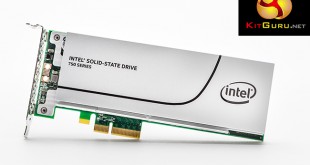
The push for greater performance from storage devices is seeing enthusiast drives transition towards PCIe-linked connections for increased bandwidth. While faster hardware is great, on paper, it is of limited use if the surrounding ecosystem is unable to put the performance increases to effective use.
That's where the SSD-optimised Non-Volatile Memory Express (NVMe) specification comes into the picture. Today we will be looking at one of the first storage devices to make NVMe accessible for enthusiast consumers – Intel's SSD 750 Series PCIe drive.
In the SSD 750 Series drive, Intel is aiming to give enthusiast consumers an SSD that is built for raw performance. There's no compromising when it comes to form factor, size, or power consumption – drive performance is the ultimate objective, with special emphasis on random operations. The big benefit that NVMe brings to the 750 Series SSD is lower latency, thanks to a combination of CPU-attached PCIe lanes and the specification's different CPU overhead.
Shipping in capacities of 400GB ($389) and 1.2TB ($1029), Intel is using a standard PCIe 3.0 x4 connector to feed the half-height, half-length (HHHL) add-in card version, while the 2.5″ (15mm-thick) alternative receives its four PCIe 3.0 lanes via the SFF-8639 connector. We actually saw an implication of more widespread consumer support for the SFF-8639 connector when we reviewed Asus' NVMe-supporting TUF Sabertooth X99 motherboard.
With head-turning performance numbers being thrown around, such as 2,400/1,200 MBps sequential read/write and 440,000/290,000 4K random read/write IOPS, let's take a closer look at Intel's SSD 750 Series drive and head on into testing.
Specification:
- Capacities: 400GB, 1.2TB.
- Interface: PCIe 3.0 x4 (NVMe).
- Form Factors: 2.5-inch with SFF-8639 connector, HHHL PCIe x4 Add-In Card (AIC).
- Memory Components: Intel 20nm MLC NAND.
- Sequential Read/Write Speeds (up to): 2,200/900 MBps (400GB), 2,400/1,200 MBps (1.2TB).
- 4K Random Read/Write (up to): 430,000/230,000 IOPS (400GB), 440,000/290,000 IOPS (1.2TB).
- Latency Read/Write (typical): 20/20 μs (400GB), 120/30 μs (1.2TB).
- MTBF: 1.2 million hours.
- Endurance Rating: 70GB Writes Per Day, Up To 219TBW (Terabytes Written).
- Warranty: 5 Years
- Power Consumption (Idle): 4W (400GB), 4W (1.2TB).
- Power Consumption (Active) Read/Write: 9/12 W (400GB), 10/25 W (1.2TB).
- Weight (up to): 195g (AIC), 125g (2.5″).
- Operating Temperature: 0-55°C (AIC), 0-70°C (2.5″).
The Advanced Host Controller Interface (AHCI) specification used with basically all consumer SSDs (and HDDs) was around long before solid-state storage became popular on the consumer market. It was designed with the operational characteristics of mechanical storage in focus, so is not particularly optimised to take advantage of solid-state storage technologies.
I guess that the racing car analogy can be drawn here. It's like having a super fast car (the equipment), on a well-built racing track (the interface), and then being limited to lower speeds by a ‘poorly-optimised' (slow) driver behind the wheel (the protocol/specification). But when you stick Lewis Hamilton – a driver who is ‘designed' for racing fast cars – behind the wheel, you get far better results.
Your physical equipment (SSD) may be capable of high speeds, and so may the interface (PCIe lanes). But they can be hampered in certain usage scenarios and workloads if the protocol in charge doesn't allow them to perform at their full potential. NVMe aims to change that by being optimised for application with PCI-fed SSDs.
Primary design points for the NVMe specification are the ability to make use of the low latency operation of non-volatile, non-mechanical storage mediums and the parallelism of modern CPUs.
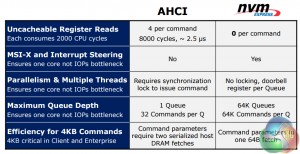
A reduction in the required CPU cycles is one of the key factors in reducing latency for NVMe. The specification also supports significantly larger data queues as well as methods of improving workload parallelism in order to avoid single-line bottlenecks.
Lower latency can result in greater operations per second (increased IOPS) which typically translates into more responsive system application.
Software, driver, and boot support has been a hurdle for NVMe. An industry consortium has worked to implement enhanced driver support across many operating systems. More relevant to consumers is that Intel and motherboard vendors have been working together to ensure that NVMe devices are seen in the UEFI BIOS and that they can be booted from.
Most X99 and other 9-series motherboards have seen recent BIOS updates that equip them with NVMe drive support. We had no problems using the SSD 750 NVMe drive in our Asus X99 Deluxe motherboard with the latest BIOS.
Intel says that there is nothing to prevent support for older platforms (such as Z87 and X79), other than motherboard vendors not wanting to spend money on ‘dead' chipsets. It is unlikely that we will see widespread, uncompromising support for PCIe, NVMe devices on older platforms, although there may be some motherboard exceptions that are updated at a vendor's discretion.
We loaded Windows 7 and Windows 8 to verify boot support. Both operating systems booted and functioned correctly with the SSD 750 drive.
Windows 8 natively includes an NVMe driver (although Intel suggests installing their own driver), however Windows 7 will require you to load the NVMe driver during OS installation. Provided you have a USB flash stick or an optical drive, that is unlikely to be an issue.
NVMe is already active in the professional world, and it is now beginning its journey on the consumer path.
We received an early sample version of Intel's SSD 750 Series drive, hence it was not accompanied by retail packaging or accessories. Retail accessories are likely to consist of a chassis sticker, a bundled half-height PCI bracket, and a driver CD.
Intel colours the SSD 750 in the company's consumer-orientated grey scheme. Given that this is an outright enthusiast drive, many consumers will be displeased by Intel's decision to use a green PCB (without a backplate).
We imagine that a black shroud and PCB/backplate would have been heavily favoured by enthusiast consumers who value system appearance.
Intel uses a PCIe 3.0 x4 connection (which can work fine in PCIe 3.0 x8 and x16 physical slots) in order to meet the SSD's bandwidth requirements. Each PCIe 3.0 lane is rated at 8GT/s (985MBps), so a quartet is required to feed the drive's ~2,400MBps sequential read potential.
While the card could function in a PCIe 2.0 slot, in theory, bandwidth would be heavily constricted. The reason that I say “in theory” is because widespread support for the SSD 750 is only available on Intel's 9-series (X99 and Z97, for example) motherboards, all of which support PCIe 3.0; vendors are unlikely to spend money creating NVMe BIOS updates for older boards.
Removing the simple shroud (that is nothing more than a thin strip of metal) gives a look at Intel's cooling configuration for the SSD 750. Intel makes no hesitation in pointing out that this drive has favoured performance over low power consumption, so with the maximum energy draw sat at 25W, the cooling system is of critical importance.
A solid sheet of metal (seemingly aluminium) with protruding fins makes firm contact with the front-side NAND packages and other components. A cut-out in that sheet allows the SSD's controller to be cooled by a dedicated heatsink that is firmly clamped in position.
Dissipating up to 25W of thermal energy in the add-in card's area is relatively challenging. Intel pointed out that it is best to install the SSD in a decent airflow case, away from other expansion cards. The “away from other expansion cards” point serves to dissuade users from sandwiching the SSD 750 between a pair of hot graphics cards where it is starved of coolant air.
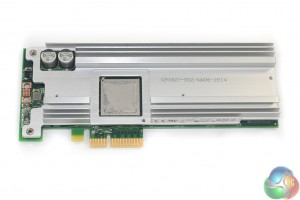
The sizeable controller (marked CH29AE41AB0) is the same piece of hardware found on Intel's DC P3700 Enterprise SSD.
Support for a PCIe connection and the NVMe specification comes via the controller, and is what sets the SSD 750 apart from many other consumer PCIe SSDs which simply RAID together a number of SATA-based controllers.
More than one SSD 750 is able to operate in RAID, although that removes boot support so may be of more relevance to users wanting a high-speed scratch disk.
Two sizeable capacitors form part of the drive's data loss protection system in the event of a power failure.
A total of 14 NAND packages (marked 29F16B08LCMFS) are found on the drive's rear side. Intel's decision to leave them running without a heatsink implies that the SSD's controller is what is drawing the bulk of the unit's 25W power consumption.
Each of the 14 rear-side NAND packages are of Intel's 20nm MLC variety and have a 16GB capacity. There are a further 18 NAND packages beneath the metal heatsink (that I was unable to safely remove on our sample, due to a tight manufacturing tolerance).
Total capacity of the drive is 1376GB, implying that the 18 front-mounted NAND packages are of a 64GB variety. 32GB of the total capacity is non user-accessible and 8% is allocated for over-provisioning, resulting in a 1.2TB functional capacity (before Windows/system conversions).
Intel rates the drive for 70GB writes per day, with a total of up to 219TBW (Terabytes Written). The company somewhat backs its claim by providing the SSD 750 with a 5 year warranty. A 5 year warranty is little to complain about, although 70x365x5 is ~125TBW, not 219. A little more confidence could have been shown with a 10-year warranty, like Samsung provides with its 850 Pro drives.
A total of five Micron DDR3-1600 SDRAM chips (marked D9PQL) are spread between the PCB's front and rear side. These serve as the drive's cache.
The provision of 400GB and 1.2TB capacities gives users a lower-cost entry point to the SSD 750 Series as well as higher capacity if they require it. I would have liked to see an in-between capacity of 800GB to provide more choice for users that work with large files, but cannot justify the 1.2TB drive.
A set of four LEDs, exclusive to the AIC drive version, show IO activity, a drive failure, drive pre-fail indication, and drive health.
There will not be performance differences between the SSD 750's PCIe card and 2.5″ versions (remember, 2.5″ is just a form factor). Both drives will get their 4-lane PCIe 3.0 connection through either the PCIe slot (AIC) or an SFF-8639 connector (2.5″). Either way, lanes are coming directly from the CPU.
For reasoning as to why an M.2 form-factor variant is not available (many motherboard M.2 slots are routed with four PCIe 3.0 lanes), we have to jump back to Intel's “no compromise” remark. The drive's controller is large, and dissipating 25W in an M.2 form-factor would be incredibly difficult with current motherboard M.2 slot designs. There's also a big limitation to how much NAND can physically fit on the M.2-sized PCB (until 3D NAND opens up truly higher capacities).
And there's no SATA-Express version because the interface's current implementation uses a PCIe 2.0 x2 link that is limited to 10Gbps (about 1GBps theoretical transfer rates). That's like limiting your 200MPH+ Bugatti to use in 70MPH zones – keep it on the track (metaphorical PCIe 3.0 x4 link) where it can really show its potential.
The 2.5″ version is intended for small form-factor systems where users cannot afford to take a motherboard expansion slot away from the graphics card.
Asus has shown one (not finalised) approach to re-routing PCIe lanes to an SFF-8639-compatible connector on the company's Hyper Kit. The small card slots into a motherboard's PCIe 3.0 x4-fed M.2 slot and provides a mini-SAS HD connector. A cable can then link the mini-SAS HD port to the 2.5″ drive's native SFF-8639 connector.
We expect to see more elegant approaches enter the market with future motherboards.
At this point in time, it only makes sense for the SSD 750 to be installed in a PCIe slot that connects directly to the CPU's lanes (not those from the Z97 or X99 chipset). That may change in the future if we see PCIe 3.0 lanes work their way onto the chipset, and if the CPU-to-chipset DMI link rate is increased.
But as it stands, the platform's DMI link (which tops out at around 1.8GBps for all devices connected to it) must be bypassed in order to achieve full performance. Connecting directly to the CPU also has the benefit of lower latency, which is one of the primary goals for the NVMe specification.
With the X99 platform's plentiful supply of PCIe lanes, usage of the SSD 750 is likely to go on without headaches. For Z97 and LGA 1150, however, PCIe 3.0 lanes are in much shorter supply.
On ‘gaming-grade' Z97 motherboards, there will be two PCIe 3.0 slots connected directly to the CPU's bank of 16 lanes. Using both of these slots will result in a maximum connection speed of PCIe 3.0 x8 for both devices. PCIe 3.0 x8 is sufficient bandwidth for the SSD 750, but reduces the graphics card's link rate from x16 (which we have tested to show a minute performance loss). No big deal, except you lose SLI capacity (which requires x8 links for each GPU).
The splitting on many higher-end Z97 motherboards is done between three PCIe 3.0 CPU-linked connectors. With all three slots populated (two graphics cards and the SSD 750), the lane configurations typically split as PCIe 3.0 x8/x4/x4. So your first card receives a PCIe 3.0 x8 link, while the second and third get an x4 link each. PCIe 3.0 x4 is the design link rate for Intel's SSD 750, but the remaining x8/x4 links can only run CrossFire, not SLI.
Please note that the above points are just examples for Z97 usage (albeit probably the most relevant ones). And when the SSD 750 card's PCIe 3.0 x4 link is referred to, the same points are true for the 2.5″ SSD version because it uses the exact same PCIe 3.0 x4 lanes, just in a different form factor.
We test the Intel SSD 750 Series drive with it installed in a dedicated PCIe 3.0 x8 slot on our Asus X99 Deluxe motherboard. This configuration ensures that bandwidth bottlenecks are eliminated.
The Asus motherboard was updated to its latest BIOS release in order to provide NVMe support.
Testing is performed with an empty drive (despite what the screenshot below shows) in order to challenge Intel's maximum performance claims.
Intel's SSD Toolbox can be used to perform drive maintenance, firmware updates, and a secure erase.
Test System:
- Processor: Intel Core i7 5960X ES.
- Memory: 16GB (4x 4GB) G.Skill Ripjaws4 2666MHz CL15 DDR4 @ 1.20V.
- Motherboard: Asus X99 Deluxe.
- Graphics Card: Asus R9 280X Matrix Platinum 3GB.
- System Drive: 500GB Samsung 840.
- CPU Cooler: Corsair H100i.
- Case: NZXT Phantom 630.
- Power Supply: Seasonic Platinum 1000W.
- Operating System: Windows 7 Professional with SP1 64-bit.
Compared SSDs:
- G.Skill Phoenix Blade 480GB (PCIe – AHCI/RAID)
- OCZ RevoDrive 350 480GB (PCIe – AHCI/RAID).
- Plextor M6e 512GB (PCIe – AHCI).
- Samsung 840 EVO 1TB (SATA 6Gbps – AHCI).
- ADATA SP610 512GB (SATA 6Gbps – AHCI).
- Plextor M6e 128GB for IOPS comparison (PCIe – AHCI)
Tests:
- AS SSD.
- ATTO.
- CrystalDiskMark.
- IOMeter.
CrystalDiskMark is a useful benchmark to measure theoretical performance levels of hard drives and SSDs. We are using V3.0.3.
Intel's SSD 750 drive makes a positive start in the CrystalDiskMark test. Sequential read and write numbers are highly impressive, as are those for 512KB transfers.
All-important 4K read performance is where the SSD 750 truly shines. While 45.57MBps 4K read is higher than a typical SATA 6Gbps SSD, 4K read with a queue depth of 32 shows superb performance for the NVMe-based solution. Supply the SSD 750 with enough work and it will show strong results.
The PCIe-fed, NVMe-compatible SSD 750 is typically outperforming (in 4K workloads) four-drive RAID 0 solutions such as G.Skill's Phoenix Blade and the OCZ RevoDrive 350.
Intel's PCIe, NVMe controller handles incompressible and compressible workloads equally well. This is always good to see as it means that you are likely to be getting full drive speed, irrelevant of your specific workload.
The ATTO Disk Benchmark performance measurement tool is compatible with Microsoft Windows. Measure your storage systems performance with various transfer sizes and test lengths for reads and writes. Several options are available to customize your performance measurement including queue depth, overlapped I/O and even a comparison mode with the option to run continuously. Use ATTO Disk Benchmark to test any manufacturer's RAID controllers, storage controllers, host adapters, hard drives and SSD drives and notice that ATTO products will consistently provide the highest level of performance to your storage.
ATTO shows off the SSD 750 1.2TB variant's strong sequential read numbers. This is important to users who are regularly transferring large files from the drive – perhaps in a video editing environment with the content is shifted off the SSD onto a backup RAID array solution.
Intel made it clear that overwhelming write performance was not the company's aim. With just over 1300MBps sequential write speeds, the SSD 750 may not be ideal for users whose workload forces them to transfer large files to the drive on a regular basis. G.Skill's and OCZ's multi-drive RAID 0 solutions confidently outperform the SSD 750 on the sequential write front.
To put it into perspective, a sequential read speed of almost 2600MBps is about four-and-a-half times as fast as the SATA 6Gbps limit, while sequential writes of 1301MBps are more than two times faster. Even a four-drive RAID array connected to the chipset will be unable to near 2600MBps due to the DMI link's ~1.8GBps limit.
AS SSD is a great free tool designed just for benching Solid State Drives. It performs an array of sequential read and write tests, as well as random read and write tests with sequential access times over a portion of the drive. AS SSD includes a sub suite of benchmarks with various file pattern algorithms but this is difficult in trying to judge accurate performance figures.
Another set of impressive performance numbers is set forward by Intel's SSD 750. Sequential read performance lingers around the 2.3GBps-mark, while AS SSD reports more than 370,000 IOPS for its 4K-64Thrd read test.
Write performance is, again, significantly lower than the read performance. A fast M.2 PCIe drive, such as a high-capacity Samsung SM951, is likely to offer higher sequential write speeds than the SSD 750. That said, the 4K-based write performance is undeniably strong.
Access times are in the low-tens of microseconds range, which is notably faster than even G.Skill's RAID 0 Phoenix Blade.
IOMeter is another open source synthetic benchmarking tool which is able to simulate the various loads placed on hard drive and solid state drive technology.
Using a queue depth of 32 (in order to test Intel's claims), the 1.2TB SSD 750 delivers just over 460,000 IOPS for the 4K random read test and more than 310,000 IOPS for 4K random write. These are slightly higher than Intel's reported numbers, which may be due to BIOS/driver updates. Random performance is a strength for the SSD 750 and its PCIe, NVMe controller.
Average I/O response time was in the fractions of milliseconds range for the read and write tasks. A high CPU utilisation was required to ensure that enough data was fed to the SSD for its full potential to be reached.
Additional testing with a queue depth of 1 saw the SSD 750 hitting 193,000 4K random read IOPS and 143,000 4K random write IOPS. Those numbers put it well above a typical SATA 6Gbps SSD and even OCZ's and G.Skill's four-drive RAID 0 solutions for random reads. However, the multi-drive RAID 0 solutions were able to register 4K random write IOPS greater than Intel's SSD 750 (~167,000 for OCZ, ~181,000 for G.Skill).
The Intel SSD 750 Series drive is a particularly high performance solution that brings an ultra-fast PCIe connection and the NVMe specification to consumer markets.
Intel's focus on read performance indicates their consumer target audience. Sequential read speeds were as high as 2.6GBps for large file transfers, while 4K random read performance with a large queue depth delivered more than 460,000 IOPS. Even with a smaller queue depth, the SSD 750's 4K random read performance neared 200,000 IOPS.
Write speeds are not as aggressive as those for read. Large transfers showed sequential write speeds as high as 1300MBps, while 4K random write testing with a large queue depth showed just over 310,000 IOPS. A smaller queue depth pulled random write performance down to a 143,000 IOPS level, at which point multi-drive RAID 0 SSD solutions are quicker.
We tested out Battlefield 4 launch and loading times and found very little (too small to accurately differentiate with a stopwatch) advantage for the SSD 750 drive. The benefits of significantly higher-speed storage devices are unlikely to show widespread advantages in games until the developers start making better use of the speed.
On the consumer market, there is nothing that matches the read performance of Intel's SSD 750 1.2TB drive. Whether your data is compressible or not, or if your workload consists of varied file sizes, the drive's read performance is superb. Write performance, however, is typically bettered by the PCIe SSDs that we are used to seeing – which consist of multiple SATA-based drives in RAID 0.
With its read performance levels, the Intel SSD 750 drive could be useful for users whose working requirements include high-resolution content editing or manipulating large engineering models. Put simply, the Intel SSD 750 is an excellent drive for users who need high read performance to cash their end-of-month pay-cheque. If your workload is based around writing, Intel's SSD 750 may not be the outright best solution.
Intel tells us that suggested pricing for the SSD 750 drives is $389 (probably around £300-350) for the 400GB version and $1029 (probably around £800-900) for the 1.2TB capacity. There should not be a price difference between the 2.5″ or AIC form factors.
Edit: Overclockers UK have the 400GB version on pre-order for £369.98 and the 1.2TB version at £969.98.
At just under $1/GB for the 400GB drive and around $0.84/GB for the 1.2TB version, these drives certainly aren't cheap. That said, many of the multi-drive RAID 0 PCIe SSDs have long dictated price points towards and above the $1/GB level, but Intel's SSD 750 comfortably outperforms them in read-heavy workloads. And the SSD 750's pricing is significantly lower than professional solutions.
Intel's SSD 750 Series drive shows levels of performance that we have yet to see on the consumer storage market at a somewhat affordable price point. While it may not be the fastest consumer drive for write operations, read performance is outstanding. And Intel's adoption of the PCIe interface and NVMe specification is also worthy of credit.
Discuss on our Facebook page, over HERE.
Pros:
- Ultra-fast sequential speeds, especially for reads.
- Very high 4K random performance, especially for reads.
- Support for boot with X99 and Z97 motherboards.
- High endurance rating and 5 year warranty.
- Can be considered competitively-priced, given the performance levels.
Cons:
- Some other drives offer higher write performance in certain workloads.
- Give enthusiasts a capacity between 400GB and 1.2TB, as well as a black PCB/backplate.
KitGuru says: A performance king for the consumer SSD market. If your workloads demand serious read performance, Intel's NVMe-based SSD 750 Series drives are a strong choice.
 KitGuru KitGuru.net – Tech News | Hardware News | Hardware Reviews | IOS | Mobile | Gaming | Graphics Cards
KitGuru KitGuru.net – Tech News | Hardware News | Hardware Reviews | IOS | Mobile | Gaming | Graphics Cards


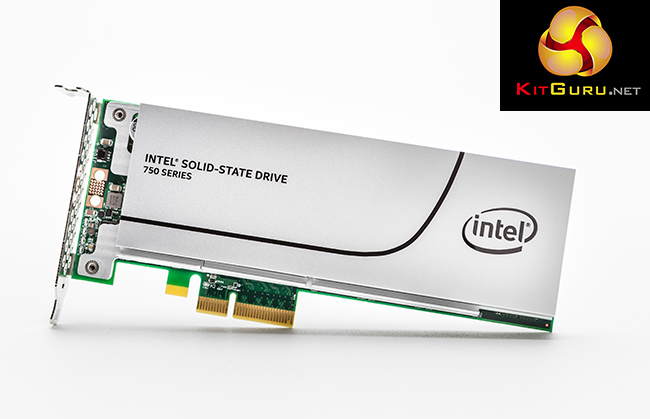
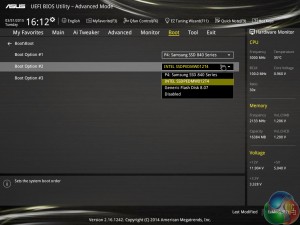
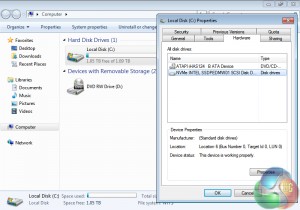
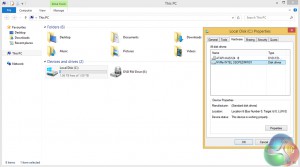
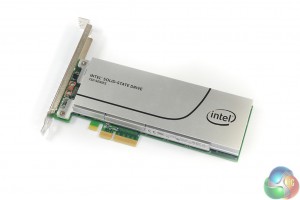
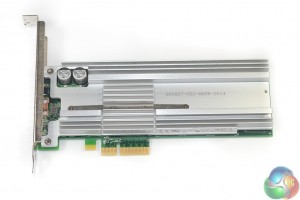
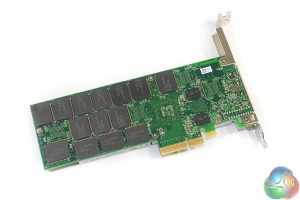
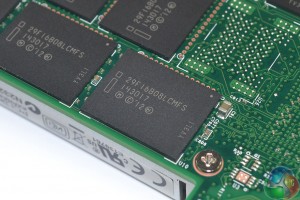
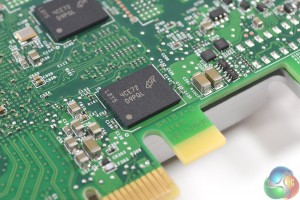
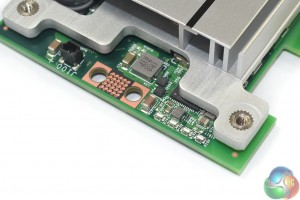
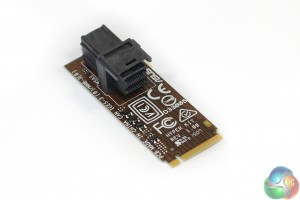
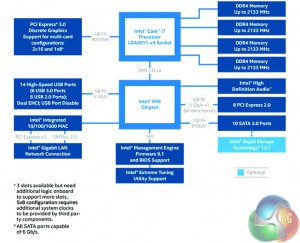
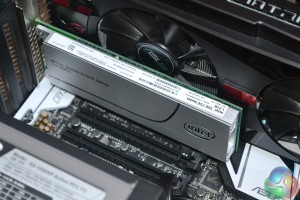
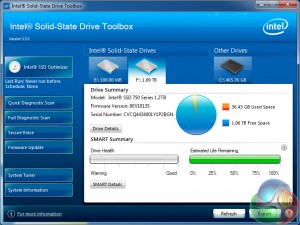
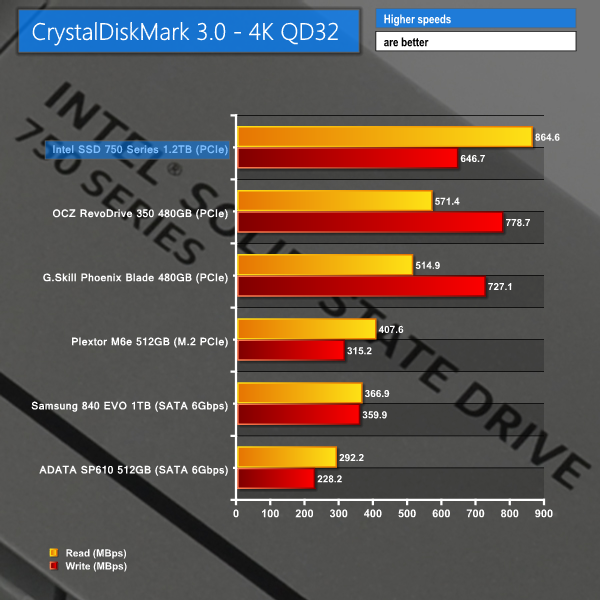
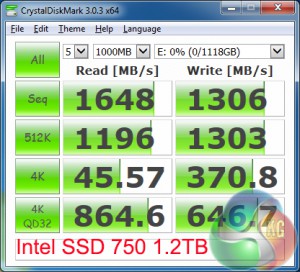
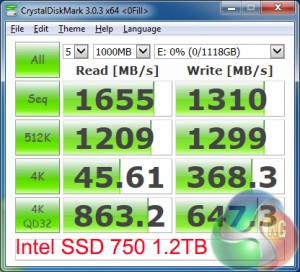
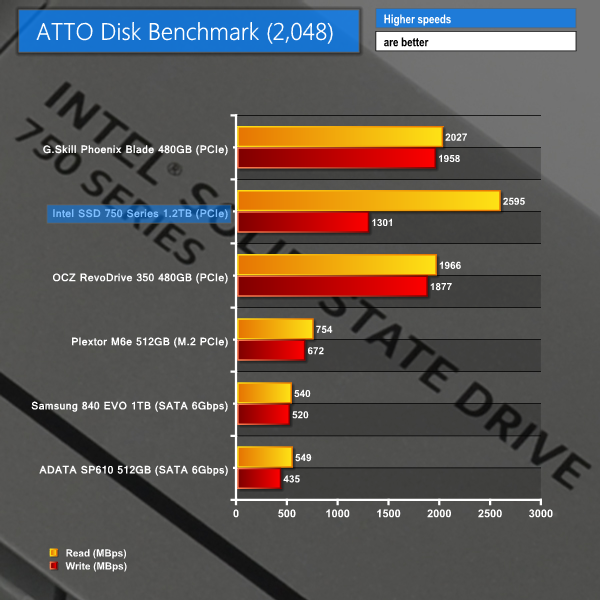
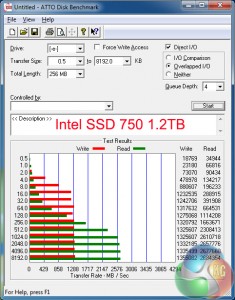
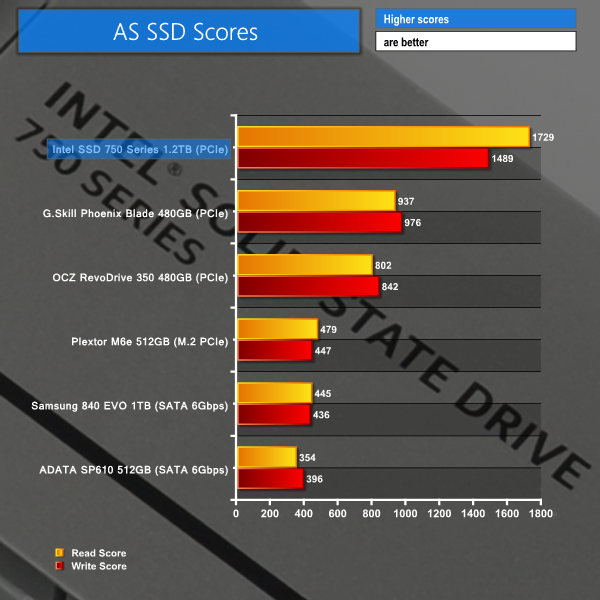
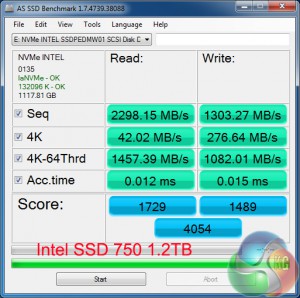
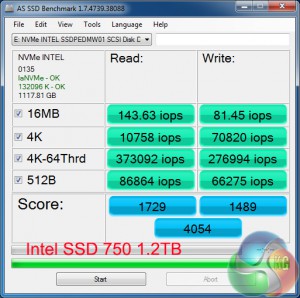
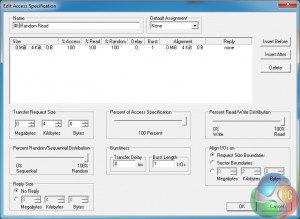
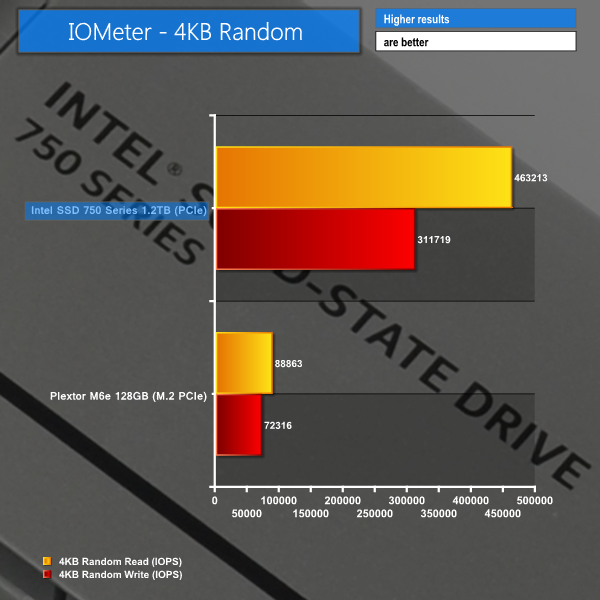
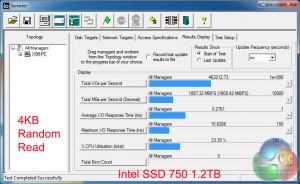
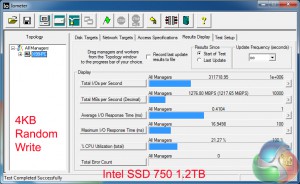


Looks great! As per with all the new stuff… Not keen on the price! Ha But absolutely do want!
Looks great! As per with all the new stuff… Not keen on the price! Ha But absolutely do want!
♋♪♪♪♪♋86$ PER HOUℛ@ai5:
Going Here you
Can Find Out,,
►►►► ::>>http://WorkOnlineMag.com/get/position…
✸✸✸✸✸✸✸✸✸✸✸✸✸✸✸✸✸✸✸✸✸✸✸✸✸✸✸✸✸✸✸
Hi Norbs,
There are some enthusiasts who stand by backplates on any expansion card they use. When dropping more than £300 or £800 on an SSD, a black backplate worth tens of pennies is not too much to ask for.
A metal backplate would also conduct heat away from the rear-mounted NAND packages, so its function is more than to prevent ‘severe clashing with one’s system’.
Luke
I just would refrain from listing it as a CON of the card; it’s performance speaks for itself. Most datacenter grade pcie cards don’t have any type of backplates. Only reason I’d agree with you would be to simply protect the NAND because
I’m pretty sure intel did their due diligence to make sure that card
does not need cooling on those NAND chips.
I think it’s fair to call it a con; many enthusiasts will want a backplate but the drive doesn’t have one. To many people, buying a piece of computer hardware is about more than just the performance (whether or not other people agree with that mindset). As we can see though, it is a clearly a minor ‘con’, hence why it’s tied in with the point for an intermediate capacity. I would be surprised if anybody chose not to buy it solely for lacking a backplate, but they may attempt a mod to make it look better in their system.
I agree that the NAND packages on the rear are unlikely to *need* cooling from a backplate – they are relatively low capacity (lower number of dies). Most people value a backplate for aesthetics although there are arguments for structural rigidity and cooling, whether or not they are actually required by the drive.
I just pointed out the lack of backplate as a con. If you personally don’t see it as a con then that’s completely fine and it can be ignored.
Luke
Why get this when you can get the Samsung SM951. Sure the SM951 is AHCI not NVMe, but 2.0 GB/s is insane regardless. On top of that, I believe it’s less expensive, and it’s nice and small due to it being M.2, therefore leaving room for your 2 or 3 GPUs, soundcard, or whatever. Plus, I’m sure Samsung will make a more consumer-ish / less OEM-ish version of the SM951 soon which I’m guessing will be NVMe, but now I’m just speculating. Anyways, Samsung SM951 all the way.
The intel kills the SM951 on iops… depends on what you are using it for and too was trying to decide which to buy. On one hand the intel 750 will perform better while on the other hand I can use the SM951 in a laptop or other device later. I also tried to see if I can even get my hands on the 512GB SM951 and the best I could do was a site that had it backordered until october 2015.
Then again the SM951 doesn’t come with a back-plate “for enthusiasts” lmao.
I agree with you, no backplate is almost a deal breaker for me
Now, I just need to win Euromillions and I will get one haha. Just kidding, I don’t have any luck…
dfyt . true that Patricia `s report is impossible… on wednesday I bought Saab 99 Turbo since I been making $8569 thiss month and also ten/k this past month
. it’s actualy my favourite-work I’ve had . I began this three months/ago and pretty much straight away was earning more than $75… p/h . you could try here HERE’S MORE DETAIL
Too funny, I just saw this drive on newegg and it seems as if the final retail version actually includes a backplate.